Designing a Scorecard for Sustainability: Slide Presentation
AHRQ Safety Program for Surgery
Slide 1: AHRQ Safety Program for Surgery—Sustainability
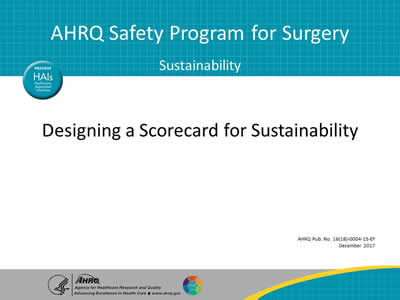
Designing a Scorecard for Sustainability
Slide 2: Learning Objectives
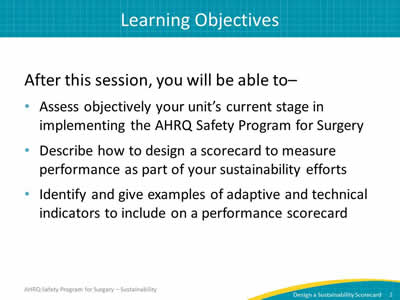
After this session, you will be able to–
- Assess objectively your unit’s current stage in implementing the AHRQ Safety Program for Surgery.
- Describe how to design a scorecard to measure performance as part of your sustainability efforts.
- Identify and give examples of adaptive and technical indicators to include on a performance scorecard.
Slide 3: Action Plan
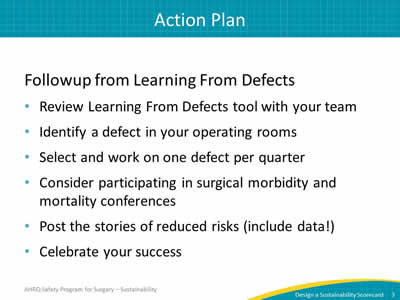
Followup from Learning From Defects:
- Review Learning From Defects tool with your team.
- Identify a defect in your operating rooms.
- Select and work on one defect per quarter.
- Consider participating in surgical morbidity and mortality conferences.
- Post the stories of reduced risks (include data!).
- Celebrate your success.
Slide 4: Checking Your Progress
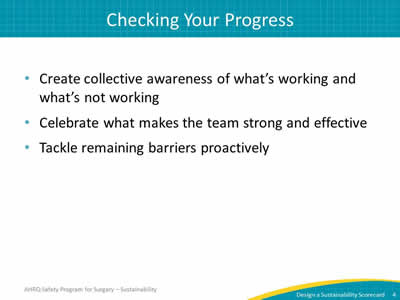
- Create collective awareness of what’s working and what’s not working.
- Celebrate what makes the team strong and effective.
- Tackle remaining barriers proactively.
Slide 5: Scorecard Parameters
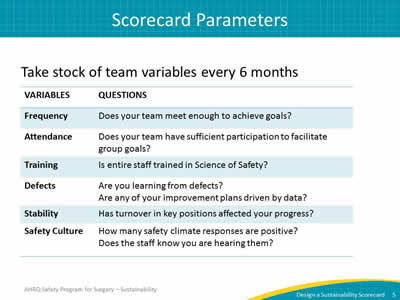
Take stock of team variables every six months.
Image: Table with headings Variables and Questions:
- Frequency: Does your team meet enough to achieve goals?
- Attendance:Does your team have sufficient participation to facilitate group goals?
- Training : Is entire staff trained in Science of Safety?
- Defects: Are you learning from defects? Are any of your improvement plans driven by data?
- Stability: Has turnover in key positions affected your progress?
- Safety Culture: How many safety climate responses are positive? Does the staff know you are hearing them?
Slide 6: Sustainability Scorecard
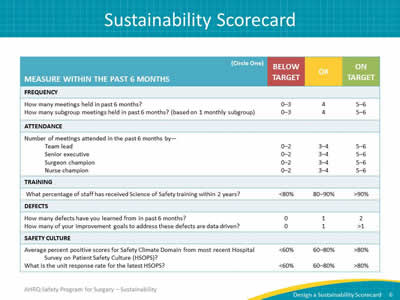
Image: A table depicting a sample sustainability scorecard.
MEASURE WITHIN THE PAST SIX MONTHS:
- Frequency: How many meetings held in past 6 months? How many subgroup meetings held in past six months? (Based on one monthly subgroup)
- Attendance: Number of meetings attended in past 6 months by—
- Team Lead.
- Senior executive.
- Surgeon champion.
- Nurse champion.
- Training: What percentage of staff has received Science of Safety training within 2 years?
- Defects: How many defects have you learned from in past 6 months? How many of your improvement goals to address these defects are data driven?
- Safety Culture: Average percent positive scores for Safety Climate Domain from most recent Hospital Survey on Patient Safety (HSOPS)? What is the unit response rate for the latest HSOPS?
Each measure has a range of answer options that fall into three columns:
- BELOW TARGET
- OK
- ON TARGET
The second column lists the level for each measure below target The third column lists the level for each measure at "OK" The fourth column lists the level for each measure on target.
Slide 7: Sustainability Scorecard
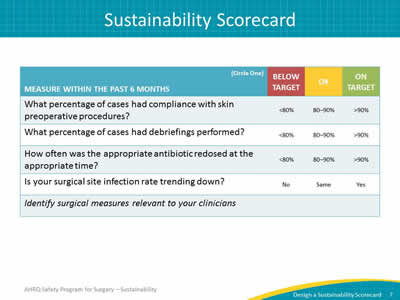
Image: A table depicting a sample sustainability scorecard.
MEASURE WITHIN THE PAST SIX MONTHS:
- What percentage of cases complied with skin preoperative procedures?
- What percentage of cases had debriefings performed? How often was the appropriate antibiotic redosed at the appropriate time?
- Is your surgical site infection rate trending down?
Identify surgical measures relevant to your clinicians.
Each measure has a range of answer options that fall into three columns:
- BELOW TARGET
- OK
- ON TARGET
The second column lists the level for each measure below target The third column lists the level for each measure at "OK" The fourth column lists the level for each measure on target.
Slide 8: Keeping an Eye on Culture
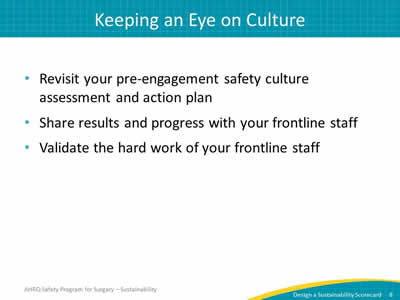
- Revisit your pre-engagement safety culture assessment and action plan.
- Share results and progress with your frontline staff.
- Validate the hard work of your frontline staff.
Slide 9: Nurture Your Safety Culture
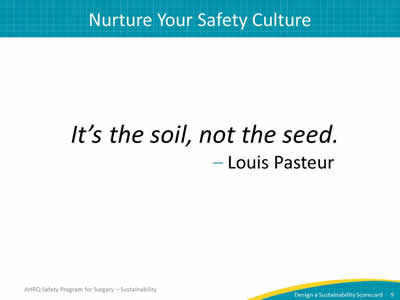
It’s the soil, not the seed.
– Louis Pasteur



